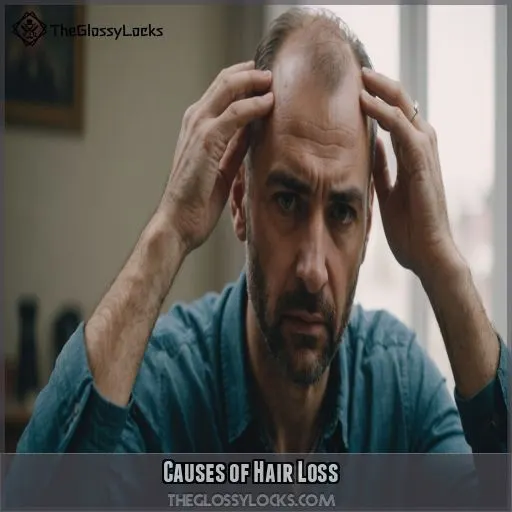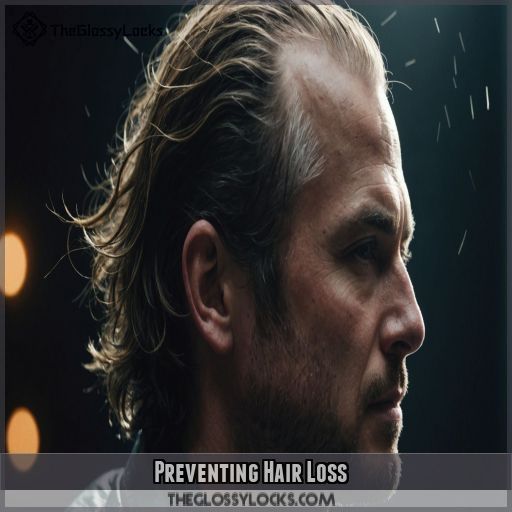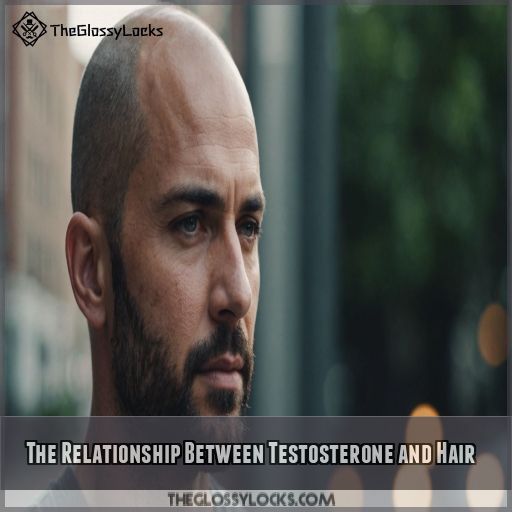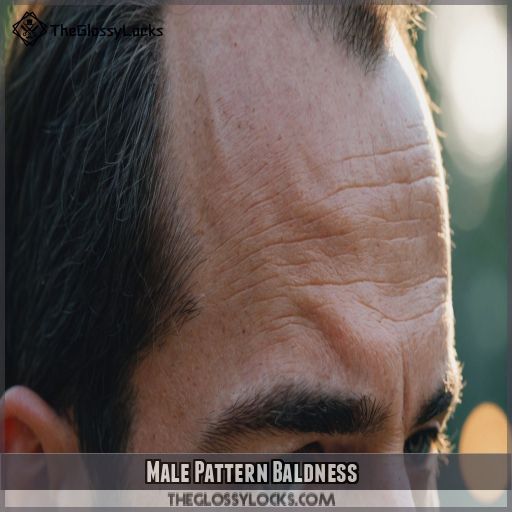This site is supported by our readers. We may earn a commission, at no cost to you, if you purchase through links.
 Yes, there’s a connection between testosterone and hair growth, but it’s not as simple as you might think. While testosterone does influence hair growth, it’s not the only factor in hair loss. The real culprit is often a more potent form of testosterone called dihydrotestosterone (DHT). But even then, it’s not just about hormone levels; genetics, age, medical conditions, and stress can all contribute to hair loss, too. So, while testosterone plays a role, it’s just one piece of the puzzle.
Yes, there’s a connection between testosterone and hair growth, but it’s not as simple as you might think. While testosterone does influence hair growth, it’s not the only factor in hair loss. The real culprit is often a more potent form of testosterone called dihydrotestosterone (DHT). But even then, it’s not just about hormone levels; genetics, age, medical conditions, and stress can all contribute to hair loss, too. So, while testosterone plays a role, it’s just one piece of the puzzle.
If you want the full scoop on how testosterone affects hair and what you can do about hair loss, keep reading!
Table Of Contents
- Key Takeaways
- Testosterone and Hair Growth
- Hair Follicle Biology
- DHT and Hair Loss
- Causes of Hair Loss
- Treatments for Hair Loss
- Preventing Hair Loss
- The Relationship Between Testosterone and Hair
- Testosterone Replacement Therapy and Hair
- Male Pattern Baldness
- Maintaining Healthy Hair
- Frequently Asked Questions (FAQs)
- Does hair growth mean high testosterone?
- Is there a relationship between testosterone and hair growth?
- Does lack of testosterone affect hair growth?
- Do hairy men have more testosterone?
- Does testosterone affect beard growth?
- Can DHT be blocked?
- What are the side effects of finasteride?
- Are there vitamins to prevent hair loss?
- Does masturbation cause hair loss?
- Conclusion
Key Takeaways
- It’s not just testosterone that affects hair growth and loss – other factors include dihydrotestosterone (DHT), a more potent form of testosterone, as well as genetics, age, medical conditions, and stress.
- The relationship between testosterone and hair loss is complex; high testosterone levels don’t guarantee hair loss, and other hormones like estradiol and prolactin also play a role in hair follicle health.
- Testosterone influences body hair growth, but it’s not the only factor – genetics also come into play, determining how sensitive hair follicles are to testosterone and DHT.
- While testosterone may contribute to male pattern baldness, maintaining healthy hair involves a holistic approach, including stress management, a healthy diet, exercise, and protecting hair from sun damage.
Testosterone and Hair Growth
You’ve probably heard the myth that testosterone causes hair loss. But is there any truth to this? Let’s explore the relationship between testosterone and hair growth, shedding light on the science behind hair loss and gain.
Does High Testosterone Equate to Hair Loss?
You might associate testosterone with hair loss, especially if you’re witnessing a thinning hairline. But does high testosterone always equate to hair loss? Let’s separate the facts from fiction.
- Myth: Having high testosterone levels will inevitably lead to hair loss.
- Fact: While testosterone plays a role in hair loss, it’s not the sole factor.
- The relationship between testosterone and hair loss is complex.
- High testosterone levels alone don’t guarantee hair loss.
- Genetics and other factors also come into play.
The Role of DHT in Hair Loss
Let’s get down to the basics of DHT and how it can mess with your hair. Dihydrotestosterone (DHT) is a stronger form of testosterone that acts like a key, binding to receptors in your hair follicles. This binding causes the follicles to shrink and produce thinner hair, eventually leading to hair loss. Men with higher DHT levels are more likely to experience pattern baldness, but women can also be affected.
| DHT | |
|---|---|
| 1 | More potent form of testosterone |
| 2 | Binds to hair follicle receptors |
| 3 | Causes follicles to shrink |
| 4 | Leads to thinner hair and hair loss |
How Testosterone Affects Hair Follicles
The relationship between testosterone and hair loss is complex. While high testosterone levels don’t always lead to hair loss, it can contribute to the process. Testosterone can be converted into DHT, a more potent form that acts on hair follicles, causing them to shrink and produce thinner hair over time.
Hair Growth Patterns in Men and Women
Now, let’s talk about hair growth patterns and how they differ between men and women. It’s not just about testosterone; other hormones are at play here too:
- Androgens stimulate hair growth in sex-specific areas, like beards for men and body hair for women.
- Estradiol (the primary female sex hormone) alters hair follicle growth and cycles, influencing hair density.
- Progesterone, another female sex hormone, decreases the conversion of testosterone to DHT, which can impact hair loss patterns.
Hair Follicle Biology
Let’s get down to the nitty-gritty of hair follicle biology. Understanding the structure and lifecycle of hair follicles is key to unraveling the mystery of hair loss.
Structure of the Hair Follicle
The hair follicle is a complex structure with multiple layers and components, each serving a specific function in hair growth and maintenance. Let’s break down the anatomy of this tiny powerhouse:
| Hair Follicle Component | Function |
|---|---|
| Upper Part (Infundibulum & Isthmus) | Forms the upper section of the follicle |
| Lower Part (Bulb & Suprabulbar Region) | Contains the hair bulb, which houses the dermal papilla and hair matrix |
| Hair Shaft | Consists of three layers: cuticle, cortex, and medulla |
| Dermal Papilla | Located within the hair bulb, it plays a key role in hair growth and anchoring |
| Hair Matrix | Rapidly dividing cells that contribute to hair shaft formation |
Understanding the intricate structure of the hair follicle is key to grasping how hormones like testosterone and DHT influence hair growth and loss.
Hair Growth Cycle and Phases
Let’s break down the hair growth cycle and its different phases. Your hair follicles go through a cycle with distinct stages: the anagen, catagen, and telogen phases. Each phase has a unique role in the growth and shedding of hair. Think of it like a well-choreographed dance, with each step building to a healthy head of hair.
Hormonal Regulation of Hair Growth
Hormones play a huge role in hair growth, and imbalances can lead to hair loss. For example, hyperandrogenism, thyroid gland diseases, and hyperprolactinemia can disrupt hair growth in people during their reproductive years.
If you’re experiencing hair loss, it’s important to understand the underlying causes, which can include hormonal imbalances, genetics, age, medical conditions, medications, and stress.
Enzymes Involved in Hair Growth
Enzymes play a big role in hair growth, specifically within the hair follicle’s dermal papilla. These include aromatase, 17 beta-HSD, 5-alpha reductase, and sulphatase. Aromatase and 5-alpha reductase are also found near the sebaceous duct and gland. These enzymes regulate hair growth and maintenance, with 5-alpha reductase being key in converting testosterone to DHT.
DHT and Hair Loss
You’ve probably heard the myth that testosterone causes hair loss. But is it true? Let’s separate fact from fiction.
Dihydrotestosterone, or DHT, is a more potent form of testosterone. It’s time to uncover its effects on your hair and whether it’s the culprit behind your receding hairline.
What is DHT and Its Effects on Hair
DHT, or dihydrotestosterone, is a more potent form of testosterone that wreaks havoc on hair follicles.
It binds to scalp receptors, causing follicles to shrink and produce thinner hair.
This leads to hair loss over time.
Men with high DHT levels are more likely to experience pattern baldness.
But don’t fret; there are ways to fight back, which we’ll uncover soon.
DHT Vs Testosterone: What’s the Difference?
DHT vs. Testosterone: What’s the Difference?
Now, let’s clear the air on the DHT and testosterone dynamic:
- DHT is like the bossy older brother of testosterone. It’s a more potent form that packs a bigger punch in terms of hair loss.
- Testosterone, on the other hand, is like the parent who’s a bit more laid-back. It has a range of responsibilities, from supporting your sex drive to building muscle.
- Think of DHT as the key that triggers hair loss. It’s the one that really gets the ball rolling, so to speak.
Can DHT Cause Male Pattern Baldness?
The short answer is yes.
DHT, a more potent form of testosterone, acts on hair follicles, causing them to shrink and leading to hair loss on the scalp.
This contributes to male pattern baldness, which typically starts with a receding hairline and hair loss on the top of the head.
Reversing or Slowing Down DHT in Men
So, what can you do about it?
Well, there’s good news and bad news. The bad news is that once those hair follicles have shrunk, it’s tough to reverse the process. The good news is that you can slow it down and take steps to keep your hair healthy.
First, let’s talk about blocking that DHT.
Causes of Hair Loss
There are a bunch of reasons why you might be losing your hair. From genetics and age to medical conditions and medications, we’ll get to the root of the problem and find out if testosterone’s the culprit.
Genetics and Hair Loss
Hair loss genes are a tricky business, and it’s not just about baldness family history. Here’s the lowdown on why some folks are more prone to hair loss than others.
- Hair Loss Genes: It’s not just a myth – hair loss genes do exist. You might’ve heard the old saying, "baldness skips a generation." Well, it’s not that simple. The inheritance patterns of hair loss can be unpredictable.
- Blame Your Parents: Hair loss can be passed down from either your mom or dad’s side of the family. So, if your grandpa was bald, it doesn’t mean your dad will be, but you might take after your grandpa.
- Genetic Testing: Wondering about your chances of going bald? Genetic testing can offer some insight. These tests look for specific variants of the AR gene, which has been linked to hair loss.
- Baldness Patterns: Male pattern baldness often starts with a receding hairline and thinning at the crown, forming that familiar "U" shape. Women typically experience thinning hair all over their scalp.
- Other Factors: Genes might load the gun, but the environment pulls the trigger. Stress, age, medical conditions, and medications can all contribute to hair loss, too. So, while genes play a role, don’t forget about these other factors!
Age and Hair Loss
| Age | Hair Loss Pattern | Hormonal Changes |
|---|---|---|
| 30s | Thinning hair, receding hairline | Testosterone levels may peak, contributing to hair loss |
| 50s | Noticeable balding, hair loss on top of the head | Hormonal imbalances, including decreased testosterone |
| 60s | Significant hair loss, balding | Hormonal changes, including decreased estrogen in women |
Medical Conditions and Hair Loss
Aside from age and genetics, certain medical conditions can trigger hair loss. Thyroid disease and lupus are known culprits, and stress is another factor that can cause your hair to thin or fall out. Alopecia, an autoimmune disease, can also lead to hair loss.
Medications and Hair Loss
Medications can also be a culprit in hair loss. Certain drugs may trigger hair shedding as a side effect. For instance, chemotherapy drugs are notorious for causing hair loss. If you’re experiencing hair loss and you’re on medication, chat with your doc to weigh your options.
Drugs that may lead to hair loss:
- Chemotherapy drugs
- Others (check with your doc)
Stress and Hair Loss
Stress and hair loss are linked. High stress levels can lead to different types of hair loss, like alopecia areata, telogen effluvium, and trichotillomania. Stress can cause inflammation around the hair follicle, disrupting its mechanisms.
Treatments for Hair Loss
So, what can you do to fight back against hair loss? Well, there are a few options on the table, from medications to surgery, and even some natural remedies. Let’s take a closer look at these treatments and see if we can find the right solution for you.
Medications for Hair Loss
If you’re looking to keep your mane, there are a few medications that might help:
- Finasteride: This drug blocks the conversion of testosterone to DHT. It’s typically prescribed for male pattern baldness.
- Minoxidil: Minoxidil is a topical solution that can be applied directly to the scalp. It works by increasing blood flow to the area and stimulating hair growth.
- Finasteride: Potential sexual side effects, including decreased libido and erectile dysfunction.
- Minoxidil: May cause scalp irritation and, rarely, increased hair loss at the beginning of treatment.
- Finasteride: Typically taken once daily as a pill.
- Minoxidil: Topical solution applied directly to the scalp, usually twice daily.
Surgery and Hair Transplantation
If you’re considering going under the knife to restore your mane, you’ve got options. Hair transplantation is a surgical procedure that moves hair follicles from a donor site to balding areas. It’s a permanent solution, but it comes with a price tag and potential risks. Before taking the plunge, weigh the costs, recovery time, and potential side effects.
Laser Therapy for Hair Growth
Laser therapy is another option for treating hair loss. It’s widely accepted that the procedure is safe, tolerable, and less invasive than hair transplant surgery. Low-level laser therapy (LLLT) uses low-dose laser treatments to invigorate circulation and stimulate hair follicles to grow hair.
Here’s what you should know:
- Laser Therapy Types: LLLT is the most common type of laser therapy for hair growth.
- Treatment Frequency: Treatment regimens vary, but typically involve short sessions a few times per week for several weeks.
- Side Effects: LLLT is considered safe and well-tolerated, but more studies are needed to determine the long-term effects.
- Cost Comparison: No information found.
- Laser vs. Medication: Laser therapy is a less invasive alternative to hair transplant surgery, but its effectiveness varies among individuals.
Natural Remedies for Hair Growth
There are a few natural remedies you might want to try to promote hair growth and reduce hair loss. These include:
- Rosemary oil: This essential oil is said to stimulate hair growth and improve scalp health.
- Coconut oil: Massaging this into your scalp can improve blood circulation and nourish hair follicles.
- Scalp massages: Regular massages can increase blood flow to the scalp, which may help with hair growth.
- Biotin supplements: Biotin is a B vitamin that supports healthy hair, skin, and nails.
- Diet changes: Eating more fruits, vegetables, and whole grains gives your body the nutrients it needs for healthy hair growth.
Preventing Hair Loss
Now that you’re clued up on treatments, let’s focus on prevention. You’ll learn how to keep your hair healthy and full, and what to avoid to sidestep hair loss.
Diet and Hair Growth
We all know that a healthy diet is important for our bodies, but did you know it can also impact your hair? Here’s the lowdown on how to eat your way to a fuller head of hair.
First things first: make sure you’re getting enough protein. Think of it as the building block for strong, healthy hair. Aim for lean proteins like chicken, fish, and beans.
Next up, don’t skimp on your vitamins and minerals. Zinc, in particular, is a key player in hair growth. You can find it in oysters, beef, and spinach.
And let’s not forget the importance of a well-rounded diet. Load up on fruits, veggies, and whole grains to give your body all the nutrients it needs to support hair health.
Exercise and Hair Growth
Exercise improves blood flow to your scalp, which is essential for delivering nutrients to your hair follicles and supporting hair growth.
- Get Moving: Regular exercise increases blood flow to your scalp, nourishing hair follicles and promoting growth.
- Boost Nutrient Delivery: Blood flow helps your follicles get the nutrients they need, like vitamins and minerals, to thrive.
- Reduce Stress: Exercise is a natural stress reliever, and managing stress is key to maintaining scalp health and preventing hair loss.
Stress Management and Hair Loss
Stress is a sneaky culprit that can trigger hair loss. It’s important to keep stress levels in check to maintain healthy hair growth. Explore stress-busting techniques like meditation, mindfulness, and breathing exercises to stay calm and keep your hair happy.
Avoiding Harsh Hair Treatments
Harsh hair treatments like chemical straightening and bleaching can damage your hair and lead to hair loss. To prevent this, opt for chemical-free products and avoid heat styling. Embrace your natural hair texture and try heat-free styling methods like braiding, scrunching, or air-drying.
Sun Protection and Hair Loss
Don’t forget about sun protection for your scalp. Slap on a hat or use sunscreen spray to shield your hair from sun damage and keep those locks healthy.
The Relationship Between Testosterone and Hair
So, does having a full head of hair mean you’re brimming with testosterone? Or is balding a sign of low testosterone? Let’s get to the root of the matter and explore the relationship between testosterone and hair growth, loss, and everything in between.
Does Hair Growth Mean High Testosterone?
Does a thick mane mean you’re brimming with testosterone? Not necessarily. While testosterone does influence hair growth, it’s not the sole factor. Here are some insights into the relationship between testosterone and hair:
- It’s Complicated: The link between testosterone and hair loss is complex. High testosterone levels don’t always lead to balding.
- DHT’s the Culprit: DHT, a potent form of testosterone, is the main driver of hair loss. It binds to receptors in hair follicles, causing them to shrink and produce thinner hair.
- Genetics Play a Part: Your genes may determine how sensitive your hair follicles are to DHT. Some people are more prone to hair loss even with normal testosterone levels.
Is There a Relationship Between Testosterone and Hair Growth?
So, is there a direct link between testosterone and hair growth? Well, it’s not quite that simple. While testosterone does play a part in the story of your hair’s thickness and lustre, it’s a supporting role rather than the leading man.
Does Lack of Testosterone Affect Hair Growth?
Yes, a lack of testosterone can impact hair growth. Here are some key points to keep in mind:
- Hormonal Balance: Testosterone plays a role in hair growth, but it’s not the only hormone involved. A delicate balance of hormones, including estradiol and prolactin, influences hair follicle health and growth.
- DHT Sensitivity: While testosterone can be converted into DHT, which contributes to hair loss, genetics may also play a role in how sensitive your hair follicles are to DHT. Some people with high testosterone levels don’t experience hair loss due to this sensitivity factor.
- Other Health Factors: Keep in mind that overall health and lifestyle choices, such as diet, exercise, and stress management, also impact hair growth. Maintaining a healthy balance in these areas can support hair health, regardless of testosterone levels.
Do Hairy Men Have More Testosterone?
So, do hairy men have more testosterone? Not necessarily. While testosterone does play a role in body hair growth, it’s not the only factor. Genetics also come into play, determining how sensitive your hair follicles are to testosterone and DHT.
Testosterone Replacement Therapy and Hair
If you’re considering testosterone replacement therapy (HRT), you’re probably wondering how it’ll affect your hair. Will it give you a luscious beard and thick locks, or speed up that receding hairline? Let’s find out.
How Testosterone HRT Impacts Hair Growth
Testosterone HRT can be a double-edged sword when it comes to hair growth.
While it may boost hair growth in some areas, it can also accelerate male pattern baldness.
It’s a delicate balance.
High testosterone levels alone don’t guarantee hair loss, but they can be a contributing factor.
It’s all about how your body uses and responds to those higher levels.
Facial Hair Growth on Testosterone
You might’ve noticed some extra fuzz on your face with higher testosterone. Here’s the lowdown on the relationship between testosterone therapy and facial hair growth:
- Hormone balance: Testosterone plays a key role in facial hair growth, especially in men.
- Beard growth patterns: While testosterone sets the stage, the hormone DHT is the main driver of beard growth.
- Facial hair changes: Testosterone therapy can enhance facial hair growth, giving you a fuller beard.
- Individual results may vary: Keep in mind, results differ from person to person. Some guys might see a lush beard, while others notice minimal changes.
Body Hair Growth on Testosterone
Body hair growth is heavily influenced by testosterone. While it’s commonly associated with facial hair, testosterone also plays a big role in the growth of body hair all over. So, if you’re noticing more hair on your chest, back, or other areas, it could be a sign of higher testosterone levels.
Hair Loss and Testosterone HRT
You might be wondering if testosterone replacement therapy (HRT) will affect your hair.
It’s a bit of a mixed bag.
While testosterone HRT can boost beard growth, it might also speed up hair loss.
How? By increasing DHT, which is linked to hair loss.
So, if you’re already prone to balding, testosterone HRT could potentially accelerate that process.
It’s something to think about.
Male Pattern Baldness
Male pattern baldness is a common concern for guys, and it’s often linked to testosterone. But is there a direct connection, or is it just a coincidence? Let’s get to the bottom of this hair-raising issue.
Understanding Male Pattern Baldness
Male pattern baldness is a common form of hair loss that typically affects men differently from women. In men, it often starts with a receding hairline and hair loss at the temples and crown, forming a distinctive "U" shape of hair around the sides and back of the head.
Genetics may play a role in male pattern baldness, with some people inheriting hair follicles that are more sensitive to DHT, a potent form of testosterone. This sensitivity causes the hair follicles to shrink, resulting in thinner hair that eventually falls out and isn’t replaced.
Signs and Symptoms of Male Pattern Baldness
Male pattern baldness typically starts with a receding hairline, thinning hair, and hair loss on the top of the head. Over time, you might notice:
- A "U" of hair around the sides and back of your head
- Increased scalp visibility
- Hair loss in other parts of your body
- Swelling, itching, or scaling around balding areas
However, some signs aren’t indicative of hair loss, such as an itchy scalp, dandruff, dry hair, or split ends.
Causes of Male Pattern Baldness
So, what’s behind male pattern baldness? Well, it’s a mix of things, including:
- Genetics: The gene you get from your parents can make your hair follicles more sensitive to DHT, a hormone that makes them shrink.
- Age: It often starts in your teens but becomes more common as you get older.
- Lifestyle and health: Certain health conditions, like thyroid issues, and medications, such as anabolic steroids, can trigger hair loss.
Treatment Options for Male Pattern Baldness
So, your hairline’s retreating faster than a soldier under fire. What can you do about it?
- Hair transplant: This surgery moves hair from thicker parts of your scalp to balding areas.
- Medications: Minoxidil and Finasteride can slow or stop hair loss, but there are risks. Finasteride, for example, can cause sexual side effects.
- Laser therapy: This non-invasive treatment stimulates hair growth with low-level lasers.
- Scalp massages: A relaxing way to boost blood flow to your scalp and potentially strengthen hair follicles.
- Herbal treatments: Rosemary oil and green tea extract may promote hair growth, but more research is needed.
Maintaining Healthy Hair
While testosterone may play a role in hair loss, maintaining healthy hair is about more than just hormones. Let’s explore the tips and tricks to promote hair growth and keep your locks looking their best.
Tips for Healthy Hair Growth
- Avoid harsh hair treatments like chemical straightening or bleaching, which can damage hair and lead to hair loss.
- Protect your hair from sun damage by wearing a hat or using sunscreen spray.
- Manage stress effectively—it’s essential for maintaining healthy hair and preventing hair loss.
Managing Hair Loss With Diet and Exercise
Managing hair loss doesn’t have to be a big deal. Here are some practical tips to empower you to take control:
- Eat a well-rounded diet rich in fruits, vegetables, and whole grains.
- Stay active. Regular exercise improves circulation and promotes healthy hair growth.
- Avoid harsh hair treatments like chemical straightening or bleaching, which can damage hair and lead to further hair loss.
- Protect your hair from sun damage by wearing a hat or using sunscreen spray when outdoors.
Reducing Stress for Healthy Hair
Stress is a common trigger for hair loss, and managing it’s key to keeping your hair healthy and lush. While it’s impossible to avoid stress entirely, you can learn to tame it.
Mindfulness practices like yoga and meditation can help you chill out and keep those stress levels in check. Think of it like a workout for your mind – the more you practice, the stronger your stress-busting skills become.
Protecting Hair From Sun Damage
Too much fun in the sun can lead to more than just sunburn. Your scalp and hair can take a beating from those rays, too. Here’s how to keep your hair healthy:
- Cover up with a hat that has a brim to shield your scalp and hair from UV rays.
- Use a hair sunscreen spray if you don’t want to wear a hat.
- Check your hair products for ingredients like citrus or spices, which can make your hair more sun-sensitive.
- Treat your hair to a hydrating mask or deep conditioner after a day in the sun.
Frequently Asked Questions (FAQs)
Does hair growth mean high testosterone?
Not necessarily. While testosterone does play a role in hair growth, it’s a bit more complicated than that. Genes, age, and other health factors also come into play. So, don’t go thinking you’re some hairy Hercules just yet.
Is there a relationship between testosterone and hair growth?
Yes, there’s a connection between testosterone and hair growth. Testosterone converts to DHT, which binds to hair follicle receptors, causing hair loss. Genetics also plays a role in hair sensitivity to DHT.
Does lack of testosterone affect hair growth?
While low testosterone may not directly cause hair loss, it can slow down male pattern baldness by reducing DHT levels. DHT is the hormone that binds to hair follicles, causing hair loss.
Do hairy men have more testosterone?
While there’s a correlation between hairiness and high testosterone levels, it’s not that simple. It’s about how the body uses testosterone, not just how much it has. Plus, genes play a part, too.
Does testosterone affect beard growth?
Testosterone levels do affect beard growth. Higher testosterone levels lead to thicker beards, while lower levels result in thinner or no facial hair. Testosterone replacement therapy can help address low testosterone and stimulate beard growth.
Can DHT be blocked?
Yes, DHT can be blocked with treatments like medicine, shampoos, and natural foods. These DHT blockers prevent DHT from binding to androgen receptors, but they may cause hormonal imbalances.
What are the side effects of finasteride?
Finasteride can cause decreased sexual ability/desire, problems getting an erection, and ejaculation issues. Rare but serious side effects include low mood, breast pain or tenderness, and testicular pain.
Are there vitamins to prevent hair loss?
Vitamins A, B, C, D, and E, along with zinc, iron, and biotin, are all essential for healthy hair growth and can help prevent hair loss.
Does masturbation cause hair loss?
Nope, that’s a myth. There’s no scientific evidence that masturbation causes hair loss. So, go ahead and enjoy some solo time without worrying about your hairline.
Conclusion
So, is hair growth related to testosterone? It’s complicated.
While testosterone does play a role in hair loss, it’s not the only factor.
DHT, genetics, age, and stress can all contribute to thinning hair.
Understanding the science behind hair loss is the first step to tackling it.
With the right mix of treatments, lifestyle changes, and maybe even a little sun protection, you can keep your hair healthy and vibrant, no matter your testosterone levels.













